![]()
![]()
![]()
Use LEFT and RIGHT arrow keys to navigate between flashcards;
Use UP and DOWN arrow keys to flip the card;
H to show hint;
A reads text to speech;
121 Cards in this Set
- Front
- Back
- 3rd side (hint)
|
Learning |
Permanent (?) Changing behavior and/or knowledge |
|
|
|
Types of Learning |
Classical Conditioning Operant Conditioning Observational Learning |
|
|
|
Classical Conditioning |
Def: Association with stimuli
An unconditioned stimulus produces an unconditioned response a neutral stimulus produces no response the unconditioned stimulus is repeatedly present just after the neutral stimulus the unconditioned stimulus continues to produce an unconditioned response the neutral stimulus alone now produces a conditioned response thereby becoming a conditioned stimulus |
Pavlov & Watson |
|
|
Example of classical conditioning |
neutral stimulus would be a gun unconditioned stimulus would be a loud noise unconditioned response would be fear. The conditioned stimulus is the gun which causes the conditioned response of fear ns: GUN > us: LOUD NOISE > ur: FEAR cs: GUN > cr: FEAR |
|
|
|
Pavlov |
Causes a dog salivate when hearing a Bell. |
|
|
|
Watson |

Extreme Behaviorist > believed he could make anybody into anything Example: he could turn you into a lawyer, criminal, doctor, or anything he wanted |
|
|
|
Learning Process |
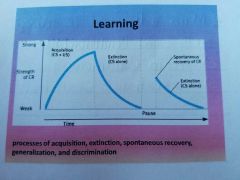
Processes of acquisition, Extinction, spontaneous recovery, generalization, and discrimination |
|
|
|
Acquisition |
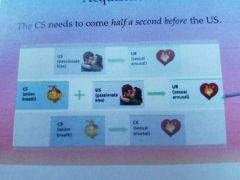
The condition stimulus needs to come half a second before the unconditioned stimulus |
|
|
|
Lil Albert |

Watson did the little Albert experiment To Lil Albert: Animals = Curiosity Loud Noise = Fear Animal + Loud Noise = Fear Causing: Animal to = Fear |
|
|
|
Operant Conditioning |
Association with consequences |
|
|
|
Skinner: Operant Conditioning |
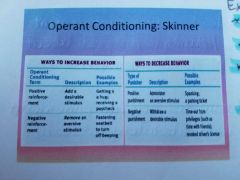
Positive Punishment Negative Punishment Positive Reinforcement Negative Reinforcement |
|
|
|
Examples of Negative Reinforcement |
Chores done = mom not screaming Seat belt on = no beeping |
|
|
|
Punishment |
Positive and negative ways to decrease Behavior |
|
|
|
Examples of Positive Punishment |
DUI - drunk driving
Spanking - parking ticket |
|
|
|
Positive Reinforcement |
Add good/wanted/desirable/pleasurable stimulus (reward) |
|
|
|
Examples of Negative Punishment |
Time out from privileges Revoked driver's license Take away allowance for chores not done |
|
|
|
Negative Punishment |
Take away privilege/desirable/pleasurable/wanted stimulus |
|
|
|
Negative Reinforcement |
Takeaway adversive/undesirable/not-pleasurable/painful stimulus |
|
|
|
Reinforcement |
Positive and negative ways to increase Behavior |
|
|
|
Examples of Positive Reinforcement |
Hug = paycheck Allowance = chores done |
|
|
|
Positive Punishment |
Add an undesirable/adverse/not-pleasurable/painful stimulus
|
|
|
|
Schedules of Reinforcement |
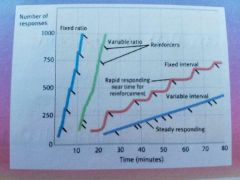
Fixed Ratio Variable Ratio Fixed Interval Steady Response |
|
|
|
Problems with Punishment |
Larzelaere & Baumrind: 1.Results in unwanted fears 2.Conveys no information to the organism 3.Justifies pain to others 4.Causes unwanted behaviors to reappear in its absence 5.Causes aggression towards the agent 6.Causes one unwanted Behavior to appear in place of another |
|
|
|
Example Problem w/Punishment |
"wait until your dad gets home" = fear when dad comes home |
|
|
|
Learned Helplessness |
Tendency to give up when conditions appear to be Beyond one's control |
|
|
|
Seligman- Learned Helplessness |
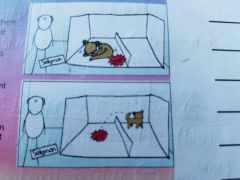
Dog with a shock collar: Zapped when it crosses divide - then shocked again when it jumps back = dog unwilling to do anything for fear of being shocked |
|
|
|
Operant Conditioning ABC model |
Using operant conditioning to change behavior is as basic as ABC A- Antecedent(s) B- Behavior C- Consequences |
|
|
|
Antecedent(s) of ABC model |
Cause/Before Things that cause the behavior |
|
|
|
Behavior of ABC model |
Target Behavior Want to change |
|
|
|
Consequences of ABC model |
Results/After antecedent(s) Works or doesn't Change if it doesn't work |
|
|
|
Target Behavior |
Behavior that does or doesn't work Behavior wish to change |
|
|
|
Deceleration vs. Acceleration Target Behavior |
Identify whether your target Behavior needs to be decelerated or accelerated. Treat deceleration Target behaviors by creating a competing response DTB: Stop excessive drinking >< ATB: Engage in Physical Activity |
|
|
|
Dead Person Rule for Deceleration Behaviours |
* Asking clients to do things they did person can do create a non-behaving circumstance * People need to know how to direct their behavior (don't just say stop tell them what to do instead) * The absence of behavior can be completed by a dead person but it's very difficult for a live one |
|
|
|
Dead Person Rule Violations |
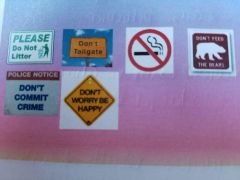
Telling them to stop without giving them directions to do something else |
|
|
|
Live Person Behaviours |
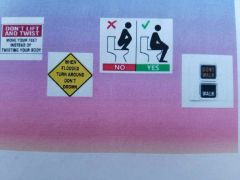
Telling them what to do instead |
|
|
|
Maintaining Antecedent(s) & Consequences |
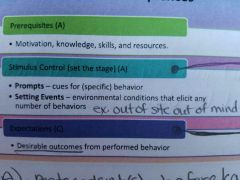
|
|
|
|
Punishment vs. Reinforcement |
Use more rewards/reinforcements than punishment
1. Condense contingent on target Behavior 2. immediately follow Behavior 3. consistent 4. communicated clearly - write it out 5. continuous than intermediate 6. natural if possible 7. changed when no longer effective |
|
|
|
4 steps to Behavior Change |
1. Describe a Target Behavior * Acceleration or Deceleration 2. Define the Maintaining Antecedents * Prerequisites * Prompts * Setting Events 3. Define the Maintaining Consequences * Desirable or Undesirable Outcomes 4. Design a specific reinforcement (or punishment) schedule |
|
|
|
Observational Learning |
Modeling |
|
|
|
Bandura - Observational Learning |
Learning through imitating others who receive rewards and punishments |
|
|
|
Bobo Doll Experiment |
* children watched a video of an adult * children given attractive toys but could not touch them * introduced to the doll * 88% of children displayed aggressive behaviors * 8 months later 40% still showed aggression |
|
|
|
Increase Imitation Conditions |
SimilarityAttractivenessTrustworthinessObserved Consequences/OutcomesPrevious similar experienceSelf-efficacyUnfamiliarity w/the task |
|
|
|
Mirror Neurons |
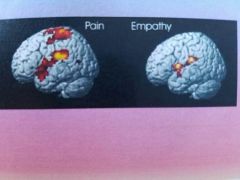
|
|
|
|
Imitation Onset |
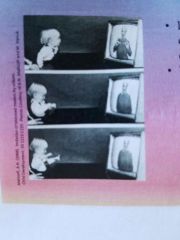
Learning by observation begins early in life Example: A 14 month old child imitates the adult on TV in pulling a toy apart |
|
|
|
TV & Imitation |
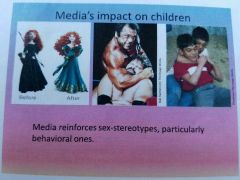
|
|
|
|
Thinking AKA Cognition |
Mental activities and processes associated with thinking knowing remembering and communicating information |
|
|
|
Thinking Concepts |
1. a concept is a mental grouping of similar objects, events, States ideas, and/or people etc. 2. A concept can be represented and communicated by an image or word such as "chair" 3. By creating definitions * e.g. a triangle is an object with 3 sides * concepts are developed from prototypes or mental images of the best example of a concept |
|
|
|
Prototype |
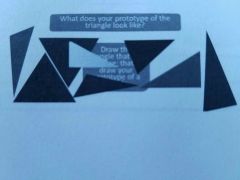
Mental images of the best example of a concept |
|
|
|
Types of Problem Solving |
Trial & Error Algorithms Heuristics Insight |
|
|
|
Trial & Error - Problem Solving |
Involves trying various possible solutions & if that fails trying others * When it's useful: perfecting an invention like the light bulb * When it fails: when there is a clear solution but trial and error might miss it forever |
|
|
|
Algorithm - Problem Solving |
Is a step-by-step strategy for solving a problem methodically leading to a specific solution |
|
|
|
Heuristics - Problem Solving |
Is a shortcut, step-saving thinking strategy or principle which generates a solution quickly (but possibly in error) |
|
|
|
Insight - Problem Solving |
Refers to a sudden realization, a leap forward in thinking, that leads to a solution The "aha" moment |
|
|
|
Barriers to Problem Solving |
Confirmation Bias Mental Set Fixation Intuition Availability Heuristic Overconfidence Belief Perseverance Framing |
|
|
|
Confirmation Bias |
Refers to our tendency to search for information which confirms our current theory disregarding contradictory evidence Not bothering to seek out information that contradicts your ideas |
|
|
|
Mental Set |
Tendency to approach problems using procedures and methods that has worked previously |
|
|
|
Intuition |
Quick acting automatic source of ideas we use instead of careful reasoning |
|
|
|
Fixation |
The tendency to get stuck in one way of thinking An inability to see a problem from A New Perspective |
|
|
|
Availability Heuristic |
We use this when we estimate the likelihood of an event based on how much it stands out in our mind, that is, how much its available as a mental reference |
|
|
|
Overconfidence Error |
Overconfidence in judgment refers to our tendency to be more confident than correct We overestimate the accuracy of our estimates, predictions, and knowledge |
|
|
|
Belief Perseverance |
Holding on to your ideas over time and actively rejecting information that contradicts your ideas |
|
|
|
Confirmation Bias vs. Belief Perseverance |
Confirmation Bias is not seeking out information that contradicts your ideas Belief Perseverance is holding on to your ideas over time and actively rejecting information that contradicts your ideas |
|
|
|
Framing |
Is the focus, emphasis, or perspective that affects our judgments and decisions |
|
|
|
Creativity |
Refers to the ability to produce ideas that are novel and valuable |
|
|
|
Convergent Thinking |
is a left brain activity involving zeroing in on a single correct answer |
|
|
|
Divergent Thinking |
creativity uses this thinking for the ability to generate new ideas new actions and multiple options and answers |
|
|
|
Creative Intelligence |
Involves using those ideas to adapt to novel situations |
|
|
|
Intelligence |
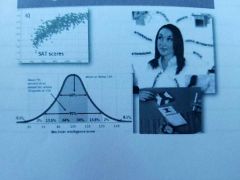
Ability to learn from experience, solve problems, and use knowledge to adapt to new situations |
|
|
|
Gardner's Multiple Intelligences |
8 Intelligences: Naturalist Musical Intrapersonal Linguistic Spatial - art Interpersonal Logical - mathematical Bodily - kinesthetic |
|
|
|
Sternberg's Intelligence Triarchy |
Practical intelligence * expertise & talent that help to complete the tasks & manage the complex challenges of everyday life Analytical intelligence * solving a well-defined problem with a single answer Creative intelligence * generating new ideas to help adapt to novel situations |
|
|
|
Normal curve |
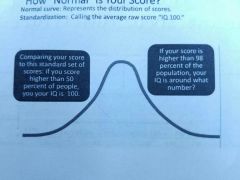
scores Represents the distribution of scoresStandardization: calling the average raw score "IQ 100" Standardization: calling the average raw score "IQ 100" |
|
|
|
Cognitive Abilities Across Lifespan |
Fluid Intelligence Crystallized Intelligence |
|
|
|
Fluid vs. Crystallized Intelligence |
fluid intelligence * the ability to think quickly and abstractly - decreases with age Crystallized intelligence * accumulated wisdom knowledge expertise and vocabulary - stay strong into old age |
|
|
|
Nature vs Nurture of Intelligence |
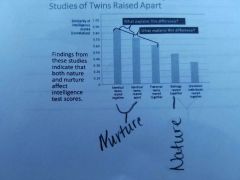
|
|
|
|
Stereotype Threat |
A feeling that one will be evaluated based on a negative stereotype * negative stereotypes cause people to not perform at their best |
|
|
|
Motivation |
a need or desire that energizes and directs Behavior |
|
|
|
Major Theories of Motivation |
* Instinct & Evolutionary Theory * Optimum Arousal Theory * Maslow's Hierarchy of Needs * Drive Reduction Theory * Incentive Theories (aka Behavioral) |
|
|
|
Instincts & Evolutionary Theory |

Fight or flight |
|
|
|
Optimum Arousal Theory |
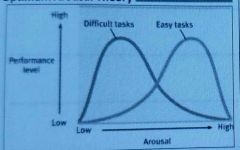
|
|
|
|
Maslow's Hierarchy of Needs |
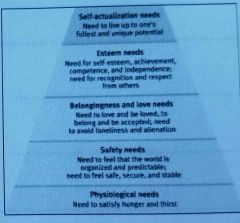
|
|
|
|
Drive Reduction Theory |

|
|
|
|
Incentive Theories (aka Behavioral) |
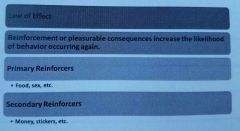
Law of effect Reinforcement or pleasurable consequences increase the likelihood of behavior occurring again Primary Reinforces * Food, Sex, Etc. Secondary Reinforces *Money, Stickers, Etc. |
|
|
|
Possible Explanations - Need for Affiliation |
Evolutionary psychology perspective: seeking bonds with others aids survival in many ways * keeping children close to caregivers * Mutual protection in a group * cooperation in hunting and sharing food * division of labor to allow growing food * emotional support to get through crises |
|
|
|
Pros & Cons - Need for Affiliation |
Pros: * Acceptance * Self-esteem * Feel Confident * Sense of Identity
Cons: * Not self-reliant * Wrong crowd: Gangs, Terrorists |
|
|
|
Ostracism |
To be cut out of or remove from a group Worse than being physically assaulted |
|
|
|
Social Media |
Associated w/: * Narcissism / Self-centeredness * Less connection to neighbors * More connection to people who share our narrow interests & viewpoints * |
|
|
|
Achievement Motivation |
a desire for: Accomplishment of goals Mastery of skills Meeting of Standards Control of resources |
|
|
|
Maslow's Self-Actualization Characteristics |
Autonomous * Privacy & Independence Realistic * accurate perception of self and others Spontaneous * open to experience Problem solvers * not just their own Appreciation * details Peak experiences * flow |
|
|
|
Intrinsic vs. Extrinsic Motivation |
Intrinsic: * motivation comes from within self Extrinsic: * motivation is provided / reward outside self |
|
|
|
Maslow's Self-Actualization |
Need to live up to one's fullest and unique potential |
|
|
|
Ego vs. Mastery Orientation |
Mastery orientation burns out less |
|
|
|
Social Facilitation |
Improve performance on tasks in the presence of others
Triplet - cyclist race times were faster when they competed against others then when they just raced against the clock. Similar to effects of Hawthorne effect in industrial organizational psychology |
|
|
|
Social Loafing |
The tendency of an individual in a group to exert less effort towards attaining a common goal than when tested individually
|
|
|
|
Leadership Styles |
Task Leadership Social Leadership |
|
|
|
social leadership |
Explaining decisions, mediating conflicts, and building high-achieving teams. Social Leaders = delegate Authority and welcome participation of team members |
|
|
|
Task leadership |
Setting standards, organizing work, and focusing attention on goals. Keep group centered on Mission. Task Leaders = directive style, which can work well if they give good orders |
|
|
|
Hunger: bio-psycho-social model |

|
|
|
|
Hypothalamus & Hunger |
Receptors in the digestive system monitor levels of glucose and send signals to the hypothalamus in the brain. The hypothalamus then can send out appetite stimulating hormones to tell the body it's time to eat |
|
|
|
Ghrelin |
Hormone that tells your body when you're hungry |
|
|
|
Leptin |
Hormone that tells your body when you're full |
|
|
|
Eating Disorders |
Anorexia Bulimia Binge-Eating Disorder |
|
|
|
Anorexia |
Restriction or avoidance of calories Heart can stop in the long term They can grow offer since your body does not have fat to keep warm Bad or low bone nutrients due to lack of potassium Fear of getting fat |
|
|
|
Bulimia |
Average or little above average eating habits Takes in a lot of calories, binge eats then purges, either throwing up or laxatives Can cause cancer and heart problems Fear of getting fat |
|
|
|
Binge-Eating Disorder |
Addiction to food Cannot stop eating It's a lot Is not afraid of getting fat |
|
|
|
Set Point |
Basal metabolic rate |
|
|
|
Dieting |
High goals Inflexible Don't plan for setbacks Give up Yo-yo |
|
|
|
Emotion |
Is a full body mind behavior response to a situation |
|
|
|
Emotional Responses |
Expressive Behavior * Yelling, Accelerating Bodily Arousal * Sweat, Pounding Heart Conscious Experience *(thoughts, especially the labeling of the emotion) What a bad driver! I am angry, even scared; better calm down |
|
|
|
Major Emotion Theories |
James-Lange Theory Canon-Bard Theory Schachter-Singer Two-Factor Theory Zajonc, LeDoux, & Lazarus: eEmotion w/out Awareness/Cognition |
|
|
|
James - Lange theory |
Emotion is our conscious awareness of our physiological responses to stimuli
Example: sight of oncoming car> pounding heart> fear |
|
|
|
Canon - Bard Theory |
We have a conscience / cognitive experience of an emotion at the same time as our body is responding not afterwards
Example: Sight of oncoming car> simultaneously causes pounding heart & fear |
|
|
|
Schachter-Singer Two-Factor Theory |
Emotions do not exist until we had the label to whatever Body Sensations we are feeling
Example: Sight of oncome car> pounding heart + I'm afraid> fear |
|
|
|
Zajonc, LeDoux, & Lazarus: Emotion w/out Awareness/Cognition |
Some emotional reactions (fear) develop via the "low road" in the brain w/out conscious thought. Example: In one study, people show an Amygdala response to certain images without being aware of the image or their reaction |
|
|
|
Carol Izzard's 10 Basic Emotions |
Infancy: * Joy * Anger * Interest * Disgust * Surprise * Sadness * Fear Learned: * Contempt * Shame * Guilt |
|
|
|
Autonomic nervous system |
Turns on when needed and turns off when not needed Examples: Pupils dialate <eyes> pupils contract Inhibits <digestion> activates Accelerates <heart> slows |
|
|
|
Hemispheric Lateralization & Emotion |
Positive emotions correlate with left frontal lobe activity Negative emotions correlate with right hemisphere activity |
|
|
|
Facial Feedback Hypothesis |
Facial position in muscle changes can alter which emotion we feel. Fake a relaxed smile and you might feel better |
|
|
|
Introvert vs Extrovert Emotion Detection in Others |
Introverts are better at detecting emotions. Extroverts have emotions that are easier to read. We are prime to detect negative emotions. People exposed to abuse are more likely to interpret fear as anger |
|
|
|
Emotion Detection - Cultural |
Greater accuracy judging emotions from their own culture |
|
|
|
Emotion Detection - Gender |
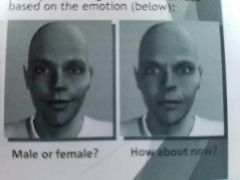
We tend to see some emotions as being more male changing our perception of a gender-neutral face based on the emotion |
|
|
|
Lies vs Genuine Emotion Detection |
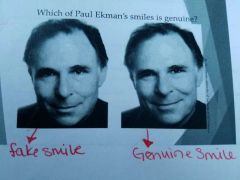
Genuine smiles have eye crinkles Visible signs of lying: eye blinks decrease, and other facial movements change. |
|

